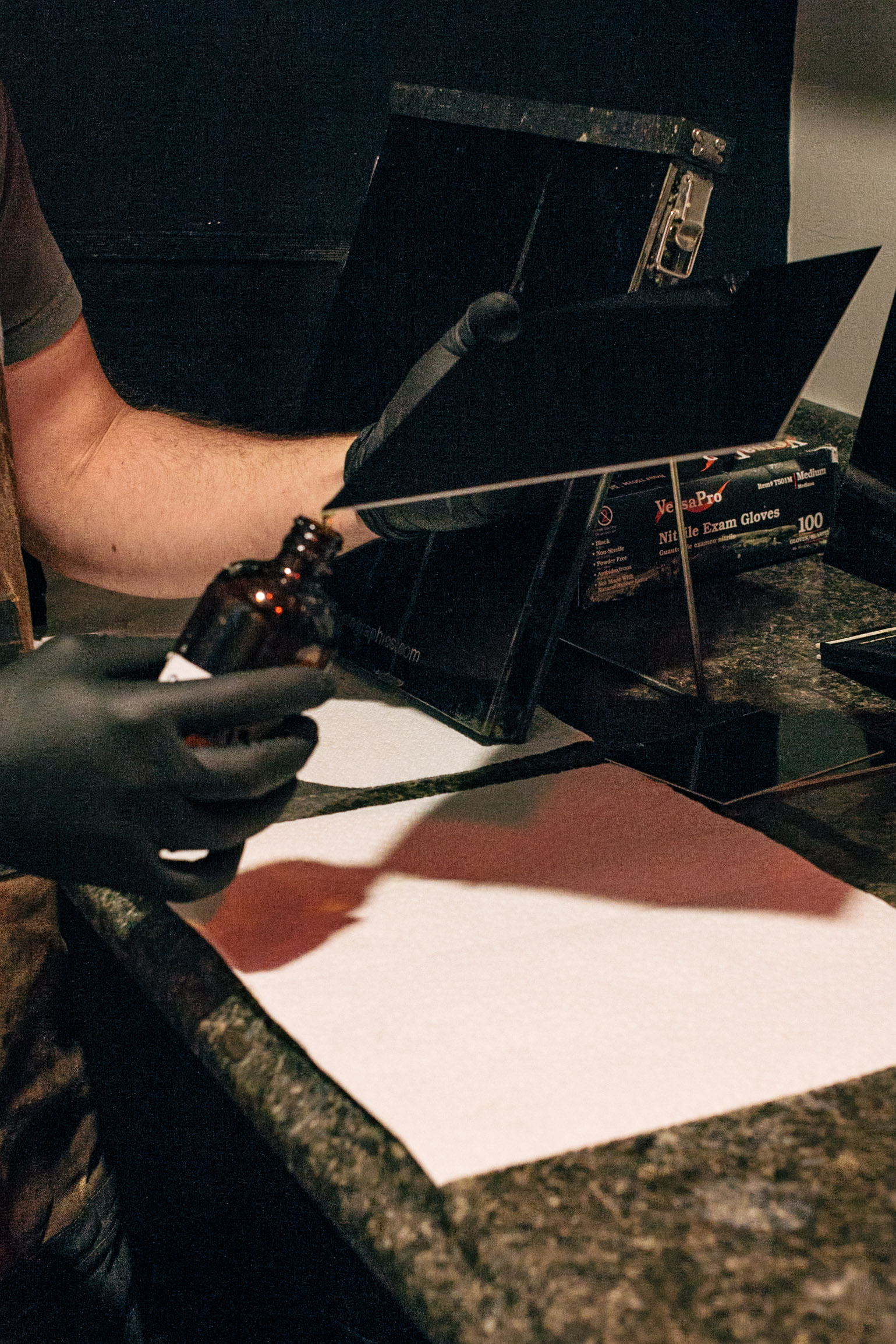Tintype Photography
Originally published in Raleigh Magazine. Words in italics are either words cut for space, or my field notes to you, the online reader.
The final transformation of a tintype portrait takes about five seconds - photographer Riley MacLean thinks it’s like watching a Polaroid from 1850. In five Mississippis, the image flips from a slightly eerie negative to a beautiful likeness. Of the process MacLean says,
“I think it amazes people. It still amazes me, after a couple thousand portraits that I’ve made. I’ve never seen someone not be excited about that.”
Photography ran in MacLean’s family for generations - he still uses some of his grandmother’s cameras - but he came into it in college, after falling in love with the darkroom and seeing an image emerge from chemicals. A decade ago, MacLean and his photography moved to the Triangle. In 2013, he began experimenting with a new (or rather, rediscovered) medium.
“I realized, working as a professional, that I spend most of my time in front of a computer, and very little time in a darkroom, or making art with my hands. I love digital photography, don’t get me wrong (I think it’s wonderful), but I missed that.”
To begin, MacLean devoured every resource he could get his hands on, including an early twentieth century Kodak manual, and compiled a list of chemicals he would need. He planned to use the same large-format (read: boxy, supported by spindly tripod legs) camera he had used in college, but needed to adapt the film holder. Instead of holding paper-thin film, it needed to accommodate a sheet of metal. The glossy, black metal turned out to be one of the more difficult items to find - he buys it now in 10x20 foot sheets, and has it cut down. All of the tanks and chemicals required could be repurposed from either science equipment or traditional darkroom uses, but there were regulations around some of the chemicals (for good reason - e.g. ether, which boils at 95 degrees Fahrenheit).
Finally, research done and materials gathered, MacLean set up his first test shot: a simple still life of a chair. It wasn’t perfect, but it held promise. The promise must’ve been strong, because after that first shot, MacLean says a “hilarious amount” of test shots did not work out. He eventually found his footing, using a mix of old and new technology for the best result. These days he opens up his orderly studio about once a month for tintype portraits.
Annemie Tonken, MacLean’s longtime friend, collaborator, and the subject for the day.
MacLean’s voice, almost always even and steady, becomes animated by two things: his work and his two Australian shepherds, who are padding around the studio during every session. The endeavor begins in the two foot by seven foot darkroom, prepping a metal plate with a fan whirring in the background, wafting away strong fumes. Details spared to maintain some of the mystery, he applies a combination of chemicals to the plate which become sensitive to light, ending with a silver bath.
Once the plate is removed, the clock is on. The plate has to get into the camera, the focus double-checked, and then the shutter slides open, exposing the plate for a split second to the subject, who is engulfed with ten-thousand watts of light. This is part of where old and new technology meet: Wet plate photography dates back to the 1830s, and ten thousand watts of light are a more recent addition. Back in the day, portrait sitters would have to sit motionless for minutes at a time while the camera collected enough lamp or day light to make a visible portrait. Now, it’s all in one burst, which subject Annemie describes as an “instant sunburn”. After the plate is exposed it is carefully brought back to the darkroom for more treatments: development (bringing out the negative image), rinsing, and then one final bath to transform it into a positive image. As he moved through each step, he talked me through it easily, with the air of a practiced explainer. Clearly a thousand curious clients had prepared him for this moment.
Rinsing.
Heat is always applied at the end of the process. The old school guys do it over an open flame, MacLean uses a heat gun (it’s safer + more efficient). He compared telling the old school guys about his heat gun to telling a coffee snob that you really love Keurig.
It’s a process that feels like magic, but MacLean compares it to cooking. Certain things have to be precise - down to a tenth of a gram - and others are to taste, changing (literally) with the weather. In the darkroom, some of the tools are basic household items, while others are combinations of hard-to-find ingredients. Although the work must be quick, it must never be hasty. In the precise method of making a tintype, MacLean explains that the image is deconstructed, tactile, and enduring.
“I wanted to make a photo that if someone wanted to airbrush, they’d have to hire a painter. If you wanted it cropped, you’d have to take it to a metal shop.”
Checking the results.
When MacLean began plotting tintypes, he loved the historical idea of a portrait: environmental factors are taken away, and you are left with the person themselves, pure and distilled. There is an intense, no-lies-told result. It is, as he said, “someone’s likeness burned onto a plate.”
To schedule a portrait with Riley and see the process for yourself, visit his website.


















